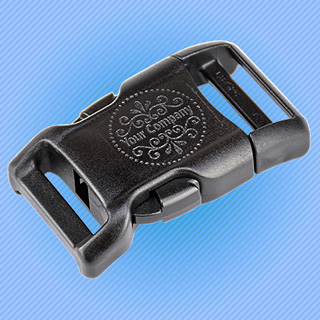From the Mailbag at Country Brook Design®


Taking orders over the phone is just one aspect of Country Brook Design®'s customer service. Questions come in from first-time crafters, do-it-yourselfers wanting to repair or replace webbing or hardware, and craft businesses considering expanding their product line. We compiled a short list of questions that might be the very thing you’ve been wondering about! If not, just email your question for a quick answer. Who knows? It might make the next “From the Mailbag”!
Q: Your prices are very competitive and the quality is superb but I don’t really need 20 yards of webbing or 10 buckles. Will you make an allowance for a smaller purchase?
Selling in bulk quantity is the business model that allows us to offer high-quality merchandise at incredibly low prices. A large inventory of pre-set lengths of yard-goods (webbing, ribbon) and packaged quantities (hardware, buckles) reduces costly man-hours and speeds up order fulfillment. These savings are passed on to Country Brook Design® customers. The majority of our customers are retailers who have an online craft business and benefit from ordering this way. However, we do offer single item purchases of our custom-made pet collars and leashes.
Q: From a cost-control aspect, what do I need to know about using leftover hardware and buckles from past projects with webbing from a new order?
On the surface, you could probably get by with that approach for some lightweight applications. For heavy use or where safety is paramount, whether it is towing, containment, or suspension, our sales staff recommends hardware that is designed for a specific webbing width. Of course, if you already have hardware in good condition that matches, by all means use it!

Cats, small breeds, and pet rocks : ) won’t put too much stress on a webbing fastener. A cargo strap or tie-down is quite another matter. Nylon and polypropylene webbing will slide and bunch somewhat if given the room. This creates wear-and-tear in spots you might not check regularly; it could also compromise the strength and weave of the webbing, potentially at the worst possible time. In order to secure and protect yourself and your cargo, our advice is to go all matchy-matchy here.
It might help to think of it this way: You could purchase shoes a size too big because the price is right. You’re probably okay walking around the house or to the mailbox. Now consider hiking, playing basketball, or working on your feet all day. Because of the extra room, your feet will slide around, your socks will bunch up, eventually blisters will form, and you’ll probably walk a little funny! We understand that it’s tempting to cut costs by using hardware you have on hand as long as it is wider than the webbing you order. Country Brook Design® specialists recommend matching hardware width to webbing width, especially for applications where strength and durability are the main concern.
Q: I bought cargo straps and tie downs years ago. The hardware seems to be in good condition but I’d like to replace the webbing. As long as it isn’t rope, is webbing material pretty much the same?
We like the way you think, at least with do-it-yourself replacement. We could make the case that you need to buy all new straps and hardware from us but we believe in the adage “use it up, wear it out, make it do, or do without” unless safety is the issue. If you’ve been using those straps long enough to need new webbing, you can probably skip “Tie-downs 101.” We do suggest that you decide whether you need to upgrade the material or perhaps change the type at the same time you order replacement webbing.
Considerations before using existing hardware:
- Check contact points for wear and tear like cuts, nicks, or rust.
- Make sure nothing is bent or worn.
- Efficient, quick-release hardware is ideal if you find yourself without a helper at times.
Next, you’ll want to consider the type of webbing material. Nylon, polypropylene or “polypro,” and polyester are the three woven strapping fabrics used for cargo straps or tie downs. These three have similarities but each one is just different enough to set it apart from the others.
| *Hold the control (ctrl) key, then press D to bookmark this reference guide. | |||
| Polyester | Nylon | Polypropylene (Polypro) | |
|---|---|---|---|
| About: | Versatile, lightweight, resilient, 100% polyester, 5X more abrasion-resistant than nylon, high melting point, high tensile strength, rot & mildew resistant, limited water absorption, available in patterns, combines best of nylon and polypro | Smooth, lustrous, durable, UV-resistant, abrasion-resistant, limited stretching under stress, high strength-to-weight ratio, machine washable, comfortable, non-irritating to skin, available in basic or bright colors for visibility and easy retrieval | Multi-purpose, economical, easy to clean, repels water, floats, doesn’t stretch under stress, recyclable, eco-friendly, resists mildew & rot, odor-resistant, colorfast, replaces nylon in many uses, more resistant than nylon to acids, alkalines, oils, and greases. |
| Uses: | Tie and cargo straps, tow and winch straps, military ratchets, boat rigging, parachuting, animal leads and collars, tent straps | Outdoor equipment, outdoor sports/activities, lifting, towing, tethering, tie-downs, cargo straps, dog collars & leashes, replacement webbing for outdoor lawn furniture | Fashion wear, children’s items, wet use applications, bags, luggage straps, sporting goods, medical equipment (easy to clean), dog collars & leashes |
| Notes: | Replace existing webbing with reflective webbing for safety and visibility. Consider patterned webbing to add flair and pizzazz to your next craft project. | Neon colors increase visibility in low light conditions and make it easy to find straps or items. | Wide color choice and better suited than nylon webbing for outdoor applications, especially if item is exposed to water or high humidity. |
| Learn More: | Polyester webbing: colors, patterns, and width options, applications, and tips. | Nylon webbing: colors, widths, and tips | Polypro webbing: colors, widths, usage ideas |
Q: At end of a busy day, the last thing I want to do is check webbing straps, dry, and roll them neatly for storage. Does it really matter much?
Other than the load you place on strapping and hardware, environmental stresses are the next most powerful enemies. Hardware can rust because of exposure to water/humidity or become sluggish due to the build-up of dirt and debris. Even strong plastic hardware can be damaged by weight. Mildew can grow on any surface and while some webbing is mildew-resistant … it isn’t mildew-proof. If time is short or it’s just too dark to see, at least find a dry spot to straighten out the straps so air can get to every surface before the next use. Before using again, “eyeball” the webbing at points of contact, make sure the fasteners are in good working condition, and run your hands along the strap to check for cuts, abrasions, or worn spots.
Q: After looking at the many options listed in your catalog, I can’t decide whether to order plastic or metal hardware for my project. Can you advise me?

The first thing to consider is how your item will be used. Plastic is best when the piece will be exposed to water or high humidity and the hardware won’t encounter outside weight or contact hard, rough, or sharp surfaces. Another consideration is application – light duty, weight of completed piece, comfort, and aesthetics. Customers also have the option to utilize our laser-engraving service on buckles to establish or further brand visibility in increasingly competitive markets.
